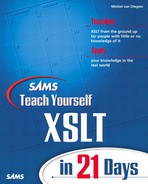Week 3
At a Glance
Last week’s lessons extended your knowledge of XSLT past its foundation. The knowledge of variables, parameters, data types, and techniques to work with multiple documents enables you to create real XSLT applications. This week you will learn more details about subjects needed to create XSLT applications with different types of functionality, such as stylesheets that perform calculations.
On Day 15, “Working with Namespaces,” you will learn how to separate unrelated data and make sure that your stylesheet processes only the data that it needs to process. You also will learn how to create documents based on namespaces.
Day 16, “Advanced Data Selection,” revisits data selection and discusses more complex types of selections. It also discusses how to get to data quickly through defined keys or ID type attributes defined in a DTD. These mechanisms enable you to select data from different parts of a document without having to use complex expressions.
On Day 17, “Using Recursion,” you will learn what recursion is and how to use it. You will learn how recursion can get you around the problem that variables can’t be changed while they are in scope.
Day 18, “Building Computational Stylesheets,” is all about creating stylesheets that perform some kind of data processing, such as statistical data analysis. You will learn that although the capabilities of XSLT are somewhat limited, you can process data in several ways.
On Day 19, “Working with XSLT Extensions,” you will learn how the XSLT language can be extended, enabling you to create stylesheets that perform functions that are very hard or impossible to achieve with regular XSLT.
Day 20, “Working with Different Processors,” looks at some of the differences between the different processors and shows you how to get around these differences. It also shows you how to deal with different versions of XSLT.
Day 21, “Designing XML and XSLT Applications,” finishes off this last week. It looks at XML and XSLT applications from a design point of view, showing you in which situations you should use a certain XML document structure or different XSLT structures.
After you finish Week 3, you will have a solid understanding of all that XSLT has to offer. This knowledge will enable you to create solid and flexible XSLT applications. Good luck!
